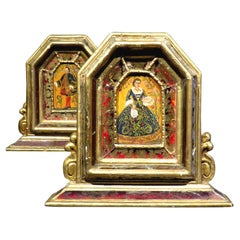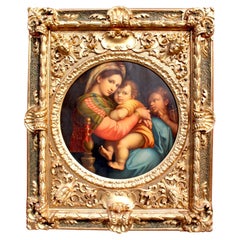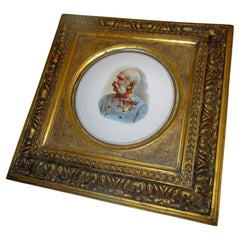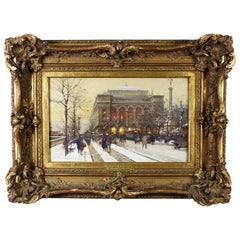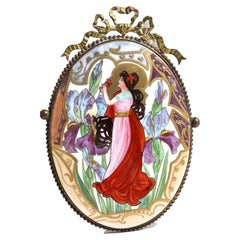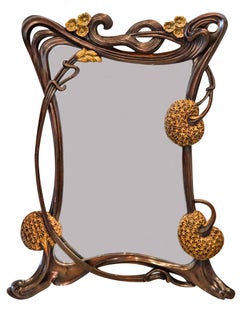Giltwood Decorative Art
13
to
10
12
13
13
13
5
1
56
181
83
8
38
14
6
13
2
3
2
1
3
2
Height
to
Width
to
8,805
128
100
56
53
12
5
3
1
1
1
1
1
Period: Early 1900s
Material: Giltwood
A Decorative Pair of Baroque Style Marriage Portraits, Continental Circa 1900
Located in Ottawa, Ontario
A highly decorative pair of hand painted marriage portraits depicting a man & woman in 17th century courtly attire.
Both figures shown surrounded by flowering vines - he surrounded b...
Category
Early 1900s European Baroque Antique Giltwood Decorative Art
Materials
Gesso, Wood, Giltwood, Paint
After Raffaello Sanzio 1483-1520 Raphael La Madonna della Seggiola Oil on Canvas
Located in Los Angeles, CA
A Fine Italian 19th Century Oil Painting on Canvas "La Madonna della Seggiola" after Raphael (Raffaello Sanzio da Urbino 1483-1520). The circular painted canvas depicting a seated Madonna holding an infant Jesus Christ next to a child Saint John the Baptist, all within a massive carved gilt wood and gesso frame, which is identical to the frame on Raphael's original artwork. This painting is a 19th Century copy of Raphael's Madonna della Seggiola painted in 1514 and currently exhibited and part of the permanent collection at the Palazzo Pitti, Galleria Palatina, Florence, Italy. The bodies of the Virgin, Christ, and the boy Baptist fill the whole picture. The tender, natural looking embrace of the Mother and Child, and the harmonious grouping of the figures in the round, have made this one of Raphael's most popular Madonnas. The isolated chair leg is reminiscent of papal furniture, which has led to the assumption that Leo X himself commissioned the painting. A retailer's label reads " Fred K/ Keer's Sons - Framers and Fine Art Dealers - 917 Broad St. Newark, N.J." - Another label from the gilder reads "Carlo Bartolini - Doratore e Verniciatori - Via Maggio 1924 - Firenze". Circa: 1890-1900.
Subject: Religious painting
Canvas diameter: 28 inches (71.1 cm)
Frame height: 54 inches (137.2 cm)
Frame width: 42 1/2 inches (108 cm)
Frame depth: 5 1/2 inches (14 cm)
Raffaello Sanzio da Urbino (Italian, March 28 or April 6, 1483 - April 6, 1520), known as Raphael, was an Italian painter and architect of the High Renaissance. His work is admired for its clarity of form, ease of composition, and visual achievement of the Neoplatonic ideal of human grandeur. Together with Michelangelo and Leonardo da Vinci, he forms the traditional trinity of great masters of that period.
Raphael was enormously productive, running an unusually large workshop and, despite his death at 37, leaving a large body of work. Many of his works are found in the Vatican Palace, where the frescoed Raphael Rooms were the central, and the largest, work of his career. The best known work is The School of Athens in the Vatican Stanza della Segnatura. After his early years in Rome much of his work was executed by his workshop from his drawings, with considerable loss of quality. He was extremely influential in his lifetime, though outside Rome his work was mostly known from his collaborative printmaking.
After his death, the influence of his great rival Michelangelo was more widespread until the 18th and 19th centuries, when Raphael's more serene and harmonious qualities were again regarded as the highest models. His career falls naturally into three phases and three styles, first described by Giorgio Vasari: his early years in Umbria, then a period of about four years (1504–1508) absorbing the artistic traditions of Florence, followed by his last hectic and triumphant twelve years in Rome, working for two Popes and their close associates.
Raphael was born in the small but artistically significant central Italian city of Urbino in the Marche region, where his father Giovanni Santi was court painter to the Duke. The reputation of the court had been established by Federico III da Montefeltro, a highly successful condottiere who had been created Duke of Urbino by the Pope - Urbino formed part of the Papal States - and who died the year before Raphael was born. The emphasis of Federico's court was rather more literary than artistic, but Giovanni Santi was a poet of sorts as well as a painter, and had written a rhymed chronicle of the life of Federico, and both wrote the texts and produced the decor for masque-like court entertainments. His poem to Federico shows him as keen to show awareness of the most advanced North Italian painters, and Early Netherlandish artists as well. In the very small court of Urbino he was probably more integrated into the central circle of the ruling family than most court painters.
Federico was succeeded by his son Guidobaldo da Montefeltro, who married Elisabetta Gonzaga, daughter of the ruler of Mantua, the most brilliant of the smaller Italian courts for both music and the visual arts. Under them, the court continued as a centre for literary culture. Growing up in the circle of this small court gave Raphael the excellent manners and social skills stressed by Vasari. Court life in Urbino at just after this period was to become set as the model of the virtues of the Italian humanist court through Baldassare Castiglione's depiction of it in his classic work The Book of the Courtier, published in 1528. Castiglione moved to Urbino in 1504, when Raphael was no longer based there but frequently visited, and they became good friends. He became close to other regular visitors to the court: Pietro Bibbiena and Pietro Bembo, both later cardinals, were already becoming well known as writers, and would be in Rome during Raphael's period there. Raphael mixed easily in the highest circles throughout his life, one of the factors that tended to give a misleading impression of effortlessness to his career. He did not receive a full humanistic education however; it is unclear how easily he read Latin.
Early Life and Works
His mother Màgia died in 1491 when Raphael was eight, followed on August 1, 1494 by his father, who had already remarried. Raphael was thus orphaned at eleven; his formal guardian became his only paternal uncle Bartolomeo, a priest, who subsequently engaged in litigation with his stepmother. He probably continued to live with his stepmother when not staying as an apprentice with a master. He had already shown talent, according to Vasari, who says that Raphael had been "a great help to his father". A self-portrait drawing from his teenage years shows his precocity. His father's workshop continued and, probably together with his stepmother, Raphael evidently played a part in managing it from a very early age. In Urbino, he came into contact with the works of Paolo Uccello, previously the court painter (d. 1475), and Luca Signorelli, who until 1498 was based in nearby Città di Castello.
According to Vasari, his father placed him in the workshop of the Umbrian master Pietro Perugino as an apprentice "despite the tears of his mother". The evidence of an apprenticeship comes only from Vasari and another source, and has been disputed—eight was very early for an apprenticeship to begin. An alternative theory is that he received at least some training from Timoteo Viti, who acted as court painter in Urbino from 1495.Most modern historians agree that Raphael at least worked as an assistant to Perugino from around 1500; the influence of Perugino on Raphael's early work is very clear: "probably no other pupil of genius has ever absorbed so much of his master's teaching as Raphael did", according to Wölfflin. Vasari wrote that it was impossible to distinguish between their hands at this period, but many modern art historians claim to do better and detect his hand in specific areas of works by Perugino or his workshop. Apart from stylistic closeness, their techniques are very similar as well, for example having paint applied thickly, using an oil varnish medium, in shadows and darker garments, but very thinly on flesh areas. An excess of resin in the varnish often causes cracking of areas of paint in the works of both masters. The Perugino workshop was active in both Perugia and Florence, perhaps maintaining two permanent branches. Raphael is described as a "master", that is to say fully trained, in December 1500.
His first documented work was the Baronci altarpiece for the church of Saint Nicholas of Tolentino in Città di Castello, a town halfway between Perugia and Urbino. Evangelista da Pian di Meleto, who had worked for his father, was also named in the commission. It was commissioned in 1500 and finished in 1501; now only some cut sections and a preparatory drawing remain. In the following years he painted works for other churches there, including the Mond Crucifixion (about 1503) and the Brera Wedding of the Virgin (1504), and for Perugia, such as the Oddi Altarpiece. He very probably also visited Florence in this period. These are large works, some in fresco, where Raphael confidently marshals his compositions in the somewhat static style of Perugino. He also painted many small and exquisite cabinet paintings in these years, probably mostly for the connoisseurs in the Urbino court, like the Three Graces and St. Michael, and he began to paint Madonnas and portraits. In 1502 he went to Siena at the invitation of another pupil of Perugino, Pinturicchio, "being a friend of Raphael and knowing him to be a draughtsman of the highest quality" to help with the cartoons, and very likely the designs, for a fresco series in the Piccolomini Library in Siena Cathedral. He was evidently already much in demand even at this early stage in his career.
Influence of Florence
Raphael led a "nomadic" life, working in various centres in Northern Italy, but spent a good deal of time in Florence, perhaps from about 1504. Although there is traditional reference to a "Florentine period...
Category
Early 1900s Italian Baroque Antique Giltwood Decorative Art
Materials
Canvas, Giltwood
After Raffaello Sanzio 1483-1520 Raphael La Madonna della Seggiola Oil on Canvas
Located in Los Angeles, CA
A Fine Italian 19th Century Oil Painting on Canvas "La Madonna della Seggiola" after Raphael (Raffaello Sanzio da Urbino 1483-1520). The circular painted canvas depicting a seated Madonna holding an infant Jesus Christ next to a child Saint John the Baptist, all within a massive carved two-tone gilt wood, gilt-patinated and gesso frame, which is identical to the frame on Raphael's original artwork. This painting is a 19th Century copy of Raphael's Madonna della Seggiola painted in 1514 and currently exhibited and part of the permanent collection at the Palazzo Pitti, Galleria Palatina, Florence, Italy. The bodies of the Virgin, Christ, and the boy Baptist fill the whole picture. The tender, natural looking embrace of the Mother and Child, and the harmonious grouping of the figures in the round, have made this one of Raphael's most popular Madonnas. The isolated chair leg is reminiscent of papal furniture, which has led to the assumption that Leo X himself commissioned the painting. Circa: 1890-1900.
Subject: Religious painting
Painting diameter: 28 inches (71.1 cm)
Frame height: 55 1/8 inches (140 cm)
Frame width: 46 inches (116.8 cm)
Frame depth: 5 1/8 inches (13 cm)
Raffaello Sanzio da Urbino (Italian, March 28 or April 6, 1483 - April 6, 1520), known as Raphael, was an Italian painter and architect of the High Renaissance. His work is admired for its clarity of form, ease of composition, and visual achievement of the Neoplatonic ideal of human grandeur. Together with Michelangelo and Leonardo da Vinci, he forms the traditional trinity of great masters of that period.
Raphael was enormously productive, running an unusually large workshop and, despite his death at 37, leaving a large body of work. Many of his works are found in the Vatican Palace, where the frescoed Raphael Rooms were the central, and the largest, work of his career. The best known work is The School of Athens in the Vatican Stanza della Segnatura. After his early years in Rome much of his work was executed by his workshop from his drawings, with considerable loss of quality. He was extremely influential in his lifetime, though outside Rome his work was mostly known from his collaborative printmaking.
After his death, the influence of his great rival Michelangelo was more widespread until the 18th and 19th centuries, when Raphael's more serene and harmonious qualities were again regarded as the highest models. His career falls naturally into three phases and three styles, first described by Giorgio Vasari: his early years in Umbria, then a period of about four years (1504–1508) absorbing the artistic traditions of Florence, followed by his last hectic and triumphant twelve years in Rome, working for two Popes and their close associates.
Raphael was born in the small but artistically significant central Italian city of Urbino in the Marche region, where his father Giovanni Santi was court painter to the Duke. The reputation of the court had been established by Federico III da Montefeltro, a highly successful condottiere who had been created Duke of Urbino by the Pope - Urbino formed part of the Papal States - and who died the year before Raphael was born. The emphasis of Federico's court was rather more literary than artistic, but Giovanni Santi was a poet of sorts as well as a painter, and had written a rhymed chronicle of the life of Federico, and both wrote the texts and produced the decor for masque-like court entertainments. His poem to Federico shows him as keen to show awareness of the most advanced North Italian painters, and Early Netherlandish artists as well. In the very small court of Urbino he was probably more integrated into the central circle of the ruling family than most court painters.
Federico was succeeded by his son Guidobaldo da Montefeltro, who married Elisabetta Gonzaga, daughter of the ruler of Mantua, the most brilliant of the smaller Italian courts for both music and the visual arts. Under them, the court continued as a centre for literary culture. Growing up in the circle of this small court gave Raphael the excellent manners and social skills stressed by Vasari. Court life in Urbino at just after this period was to become set as the model of the virtues of the Italian humanist court through Baldassare Castiglione's depiction of it in his classic work The Book of the Courtier, published in 1528. Castiglione moved to Urbino in 1504, when Raphael was no longer based there but frequently visited, and they became good friends. He became close to other regular visitors to the court: Pietro Bibbiena and Pietro Bembo, both later cardinals, were already becoming well known as writers, and would be in Rome during Raphael's period there. Raphael mixed easily in the highest circles throughout his life, one of the factors that tended to give a misleading impression of effortlessness to his career. He did not receive a full humanistic education however; it is unclear how easily he read Latin.
Early Life and Works
His mother Màgia died in 1491 when Raphael was eight, followed on August 1, 1494 by his father, who had already remarried. Raphael was thus orphaned at eleven; his formal guardian became his only paternal uncle Bartolomeo, a priest, who subsequently engaged in litigation with his stepmother. He probably continued to live with his stepmother when not staying as an apprentice with a master. He had already shown talent, according to Vasari, who says that Raphael had been "a great help to his father". A self-portrait drawing from his teenage years shows his precocity. His father's workshop continued and, probably together with his stepmother, Raphael evidently played a part in managing it from a very early age. In Urbino, he came into contact with the works of Paolo Uccello, previously the court painter (d. 1475), and Luca Signorelli, who until 1498 was based in nearby Città di Castello.
According to Vasari, his father placed him in the workshop of the Umbrian master Pietro Perugino as an apprentice "despite the tears of his mother". The evidence of an apprenticeship comes only from Vasari and another source, and has been disputed—eight was very early for an apprenticeship to begin. An alternative theory is that he received at least some training from Timoteo Viti, who acted as court painter in Urbino from 1495.Most modern historians agree that Raphael at least worked as an assistant to Perugino from around 1500; the influence of Perugino on Raphael's early work is very clear: "probably no other pupil of genius has ever absorbed so much of his master's teaching as Raphael did", according to Wölfflin. Vasari wrote that it was impossible to distinguish between their hands at this period, but many modern art historians claim to do better and detect his hand in specific areas of works by Perugino or his workshop. Apart from stylistic closeness, their techniques are very similar as well, for example having paint applied thickly, using an oil varnish medium, in shadows and darker garments, but very thinly on flesh areas. An excess of resin in the varnish often causes cracking of areas of paint in the works of both masters. The Perugino workshop was active in both Perugia and Florence, perhaps maintaining two permanent branches. Raphael is described as a "master", that is to say fully trained, in December 1500.
His first documented work was the Baronci altarpiece for the church of Saint Nicholas of Tolentino in Città di Castello, a town halfway between Perugia and Urbino. Evangelista da Pian di Meleto, who had worked for his father, was also named in the commission. It was commissioned in 1500 and finished in 1501; now only some cut sections and a preparatory drawing remain. In the following years he painted works for other churches there, including the Mond Crucifixion (about 1503) and the Brera Wedding of the Virgin (1504), and for Perugia, such as the Oddi Altarpiece. He very probably also visited Florence in this period. These are large works, some in fresco, where Raphael confidently marshals his compositions in the somewhat static style of Perugino. He also painted many small and exquisite cabinet paintings in these years, probably mostly for the connoisseurs in the Urbino court, like the Three Graces and St. Michael, and he began to paint Madonnas and portraits. In 1502 he went to Siena at the invitation of another pupil of Perugino, Pinturicchio, "being a friend of Raphael and knowing him to be a draughtsman of the highest quality" to help with the cartoons, and very likely the designs, for a fresco series in the Piccolomini Library in Siena Cathedral. He was evidently already much in demand even at this early stage in his career.
Influence of Florence
Raphael led a "nomadic" life, working in various centres in Northern Italy, but spent a good deal of time in Florence, perhaps from about 1504. Although there is traditional reference to a "Florentine period...
Category
Early 1900s Italian Baroque Antique Giltwood Decorative Art
Materials
Canvas, Giltwood
KPM Porcelain Painting of Franz Josef of Austria in Ornate Giltwood Frame
Located in Savannah, GA
This detailed KPM porcelain plaque features a painting of Franz Joseph and is beautifully accentuated by a wide ornate antique giltwood frame. The porcelain circle measures seven and...
Category
Early 1900s German Baroque Revival Antique Giltwood Decorative Art
Materials
Porcelain, Giltwood
Italian Giltwood Sunburst
Located in Dallas, TX
Antique Italian carved and giltwood sunburst element. Circa 1900. Perfect for today's transitional designs!
Category
Early 1900s Antique Giltwood Decorative Art
Materials
Giltwood
Eugène Galien-Laloue "Theatre du Chatelet" Watercolor and Gouache
Located in Los Angeles, CA
Eugène Galien-Laloue (1854-1941) "Theatre du Chatelet" watercolor and gouache on paper signed 'E Galien Laloue' lower left, within a giltwood and gesso c...
Category
Early 1900s French Belle Époque Antique Giltwood Decorative Art
Materials
Glass, Giltwood, Paper
Eugenio Zampighi 'Italian, 1859-1944' 19th/20th C. Oil on Canvas "Joyous Family"
Located in Los Angeles, CA
Eugenio Zampighi (Italian, 1859-1944) A fine and charming Italian 19th/20th century oil on canvas Titled "A Joyous Family" depicting an interior scene of a seated joyous mother with her smiling toddler child on her lap, as her young daughter amuses them while holding a small kitten picked-up from the cat...
Category
Early 1900s Italian Country Antique Giltwood Decorative Art
Materials
Gesso, Canvas, Giltwood
Italian 19th Century Porcelain Plaque of Madonna della Primavera, after Barabino
By Nicolò Barabino
Located in Los Angeles, CA
A very fine Italian 19th century porcelain plaque of Madonna della Primavera ("Madonna detter Primavera with Bambino"), after Nicolò Barabino (1831-1891). The finely painted standing Madonna holding baby Jesus in her arms surrounded by flowers, framed in a Gothic revival style giltwood carved frame. The back inscribed: "Madonna detter Primavera - nach Barabino" and handwritten "E. Guenther, Phila". Signed lower left corner, circa 1890-1900.
Nicolò Barabino (1831–1891) was an Italian academic painter of religious and historical subjects, active in Florence and Genoa.
He was born in Sampierdarena. His initial studies were at the Genovese Accademia Ligustica di Belle Arti, under Giuseppe Isola. In Genoa, he befriended Maurizio Dufour. In 1857, he won the Durazzo scholarship to attend the Accademia di Belle Arti in Florence. He designed some of the lunettes completed as mosaics for the portals of the Florence Cathedral...
Category
Early 1900s Italian Gothic Revival Antique Giltwood Decorative Art
Materials
Porcelain, Giltwood
Ornately Giltwood Framed Floral Painting by Charles Franzini D’issoncourt
Located in Miami, FL
Original oil on canvas painting by the very talented French artist Charles Henri Franzini d’Issoncourt who won an award in Paris at the Universal Exposition in 1900 for his artwork. ...
Category
Early 1900s French Baroque Antique Giltwood Decorative Art
Materials
Canvas, Paint, Giltwood
French Still Life Floral Painting by Charles Franzini d’Issoncourt
Located in Miami, FL
This captivating 19th-century still life oil painting by the award-winning French artist Charles Henri Franzini d'Issoncourt is a testament to his artistic talent. Recognized at the ...
Category
Early 1900s French Baroque Antique Giltwood Decorative Art
Materials
Canvas, Paint, Giltwood
Karl Viktor Mayr, Austrian Oil on Canvas "An Exotic Nude Girl"
By Karl Viktor Mayr
Located in Los Angeles, CA
Karl Viktor Mayr (Austrian, 1882-1974) a very fine Austrian oil on canvas "An Exotic Nude Girl" depicting a young semi-nude woman, revealing her breast...
Category
Early 1900s Austrian Folk Art Antique Giltwood Decorative Art
Materials
Canvas, Giltwood
Federico Ballesio Attributed 'Italian, 19th Century' Watercolor "The Courting"
By Francesco Ballesio 2
Located in Los Angeles, CA
Attributed to Federico Ballesio (Italian, 19th Century) a fine Italian watercolor and gouache on paper "The Courting". The finely painted watercolor ...
Category
Early 1900s Italian Country Antique Giltwood Decorative Art
Materials
Giltwood, Paper
Large Danish Neoclassical Giltwood Concave Sided Mirror
Located in Haddonfield, NJ
The mirror is made by F.C Mailand Hansen, a well known glazier from Copenhagen, Denmark.
The mirror is dated to between 1900-1910.
It is in neoclassical Revival style, and has an ama...
Category
Early 1900s Danish Neoclassical Revival Antique Giltwood Decorative Art
Materials
Mirror, Giltwood
Related Items
Continental Porcelain Oval Plaque circa 1900
Located in West Palm Beach, FL
A Continental porcelain oval plaque
circa 1900
painted with a beauty holding a rose after Nathaniel SICHEL (1843-1907), impressed C above 170, within a ...
Category
Early 1900s Antique Giltwood Decorative Art
Materials
Porcelain
Antique KPM Hand-Painted Porcelain Cabinet Plate Depicting the Biblical "Ruth"
Located in Hamilton, Ontario
This antique hand-painted porcelain cabinet plate was made by the renowned KPM porcelain factory of Germany in approximately 1880. The center of the plate features a depiction of the...
Category
Late 19th Century German Neoclassical Revival Antique Giltwood Decorative Art
Materials
Porcelain
Italian Neoclassical Giltwood Decorated Boiserie Overdoor Panel
Located in Nashville, TN
With a faux ( not real ) marble central inset .The crème ground with raised gilded carvings of stylized winged sphinx , Nike , ribbons , Ram’s heads , rosettes and garlands or festo...
Category
Late 19th Century Italian Neoclassical Antique Giltwood Decorative Art
Materials
Giltwood
Oil on Canvas Painting 20th C Beach Seascape Greek Artist Born Paris LA gallery
Located in West Hollywood, CA
Oil on Canvas Painting 20th C Beach Seascape Greek Artist Born Paris LA gallery
George Yoldjoglou oil on canvas animated beach scene H: 22" Width: 24". The beach Scene with beautiful vibrant colors, sand and people playing, umbrellas boats.
Born in 1933 in Paris of Greek origin.
His first exposition was in 1952 and has had continuous expositions not only throughout France but in other countries and nations. His works are marked in Salons and famous museums in Paris, Versailles, Cannes, Antibe, Avignon, Peru, and in Foundations and Collections of such as Baron Rothschild, Prince de Polignac, Konrad Adenauer...
Category
20th Century French Giltwood Decorative Art
Materials
Canvas
H 22 in W 24 in D 1.5 in
Oil on Canvas of Reclining Nude
Located in Cypress, CA
Beautiful oil on canvas of reclining blonde nude on a white bed sheet. Framed.
Signed (see attached photo).
20th century.
Painting dimensions: H. 20...
Category
20th Century Giltwood Decorative Art
Materials
Canvas
Pair of Original Vintage Botanical Prints, circa 1900
Located in St Annes, Lancashire
Great images of medicinal plants
Unframed.
Published, circa 1900.
Category
Early 1900s English Edwardian Antique Giltwood Decorative Art
Materials
Paper
Framed Virgin Mary Print with Carved Wood Frame, Mexico
Located in Oklahoma City, OK
An unusual print of the Virgin Mary on board, and framed in a carved wood frame. This piece was purchased in Mexico a decade ago and features Mary with several hidden faces of variou...
Category
20th Century Mexican Bohemian Giltwood Decorative Art
Materials
Wood
Painting, Modern Art Gouache, Midcentury, Tan and Black Colors, Framed, C 1960
Located in New York, NY
Midcentury, modern art painting, circa 1960, gouache.
The picture frame has damages.
Category
1960s American Mid-Century Modern Vintage Giltwood Decorative Art
Materials
Paint
H 24.75 in W 21 in D 0.75 in
Casa Devall Sunburst Wall Sculpture
By Casa Devall
Located in Los Angeles, CA
Sunburst wall sculpture with a hammered brass center and two layers of painted rods creating a sunburst effect. The artist hand signed the sculpture on the verso.
Category
1970s American Mid-Century Modern Vintage Giltwood Decorative Art
Materials
Brass
Pair of Antoni Gaudi Decorative Ceramic Spanish Tiles of Casa Vicens, circa 1888
By Antoni Gaudí
Located in Barcelona, Barcelona
Decorative ceramic tiles by Antoni Gaudi, inspired by the marigold and dianthus motifs on the decorative ceramic tiles he designed for the facade of Casa Vicens, which constitute som...
Category
1880s Spanish Jugendstil Antique Giltwood Decorative Art
Materials
Ceramic
H 5.91 in W 5.91 in D 0.4 in
19th Century Theatre Themed Limoges Enamel Painting
Located in London, GB
This charming enamel painting shows a gentleman, centrally positioned, being led by two women, one on each arm. The woman on his left has a troubled expression, her hair is grey, and she wears a dark red shawl and green costume, with a knife stored under her belt. She points up to the sky with her left hand. By comparison, the woman on the gentleman’s right looks cheerful, she has youthful blond hair, and is clad in a pink and white dress...
Category
19th Century French George II Antique Giltwood Decorative Art
Materials
Enamel
Wall Brass Holy Water Font Hand Painted Porcelain of the Sistine Madonna
Located in Guaynabo, PR
This is a hand painted KPM style rectangular plaque of the Sistine Madonna framed in a wall brass holy water font. The brass frame depicts three arcs, two small semicircular in the s...
Category
Early 20th Century Unknown Renaissance Giltwood Decorative Art
Materials
Brass
H 14.75 in W 7.25 in D 1.5 in
Previously Available Items
French 1900 Art Nouveau Mirror Carved in Wood with Gilded Lotus Flowers
Located in Miami, FL
Art nouveau mirror attributed to Louis Majorelle.
Very beautiful and elegant wall mirror, created during the Art Nouveau period in France, back in the 1900. Made in precious wood ...
Category
Early 1900s French Art Nouveau Antique Giltwood Decorative Art
Materials
Gold, Gold Leaf
H 48.12 in W 39.3 in D 0.2 in
Original Antique Miniature Print of a Gentleman in Military Costume
Located in St Annes, Lancashire
Great image of military gentleman. Sitter unknown
Wonderful slightly distressed antique giltwood frame
Published by Connoisseur, circa 1900.
The measurement below is the fra...
Category
Early 1900s English Edwardian Antique Giltwood Decorative Art
Materials
Paper, Giltwood
Free Shipping
H 9 in W 8.25 in D 2 in
Pair of Framed Gold and Silver Leaf Italian Sunburst Mirrors with Gilt Fragments
Located in Birmingham, AL
Beautiful pair of framed gold and silver leaf Italian sunburst mirrors with giltwood fragments from Florence, Italy, circa 1900s.
Dimensions:
H 37.75"
W 26"
D 1.75".
Category
Early 1900s Italian Antique Giltwood Decorative Art
Materials
Giltwood
H 37.75 in W 26 in D 1.75 in
Framed Gold and Silver Leaf Italian Sunburst Mirror with Giltwood Fragments
Located in Birmingham, AL
Beautiful framed gold and silver leaf Italian sunburst mirror with giltwood fragments from Florence, Italy, circa 1900s.
Dimensions:
H 37.75"
W 26"
D 1.75".
Category
Early 1900s French Antique Giltwood Decorative Art
Materials
Giltwood
H 37.75 in W 26 in L 37.75 in
Pair of Italian Carved Giltwood Panels, circa 1900s
Located in Los Angeles, CA
Pair of hand carved giltwood panels that were originally part of a larger piece of furniture. They were cabinet doors as you can still see the k...
Category
Early 1900s Italian Baroque Antique Giltwood Decorative Art
Materials
Metal
Frank Enders, Oil on Canvas Cupid and Psyche after Bouguereau
By William-Adolphe Bouguereau, Frank Enders
Located in Los Angeles, CA
Frank Enders (American, 1860-1921) "Cupid & Psyche" oil on canvas after William-Adolphe Bouguereau (French, 1825-1905) depicting Cupid capturing his mortal love, Psyche, within a giltwood carved frame. Signed: Frank Enders (l/l). The reverse reads: "Frank Enders, After W.A. Bouguereau, Paris, Cupid and Pyske". A frame label reads: "J.O. Krimbholz - Fine Arts - Milwaukee".
In the 19th century, Cupid and Psyche was a source for "transformations," visual interludes involving tableaux vivants, transparencies and stage machinery that were presented between the scenes of a pantomime but extraneous to the plot. During the 1890s, when tableaux vivants or "living pictures" were in vogue as a part of vaudeville, the 1889 Psyché et l'Amour of Bouguereau was among the artworks staged. To create these tableaux, costumed performers "froze" in poses before a background copied meticulously from the original and enlarged within a giant picture frame. Nudity was feigned by flesh-colored bodystockings that negotiated standards of realism, good taste, and morality. Claims of educational and artistic value allowed female nudes—a popular attraction—to evade censorship. Psyché et l'Amour was reproduced by the scenic painter Edouard von Kilanyi, who made a tour of Europe and the United States beginning in 1892, and by George Gordon in an Australian production that began its run in December 1894. The illusion of flight was so difficult to sustain that this tableau was necessarily brief. The performer billed as "The Modern Milo" during this period specialized in recreating female sculptures, a Psyche in addition to her namesake Venus de Milo.
Frederick Ashton choreographed a ballet Cupid and Psyche with music by Lord Berners and decor by Sir Francis Rose...
Category
Early 1900s American Romantic Antique Giltwood Decorative Art
Materials
Canvas, Giltwood
Read More
At Colonial Williamsburg, Everything Old Is New Again
With the help of a new director, the Virginia institution's folk art and decorative arts museums are undergoing extensive upgrades.
New York’s Hirschl & Adler Showcases the American Workmanship and Design Panache of Neoclassical Treasures
The gallery's latest exhibition proves that museum-quality pieces entice and inspire, whether in traditional or more modern interiors.
Recently Viewed
View AllMore Ways To Browse
Thomas Rowlandson On Sale
Carole Stribling
Erwin Rommel
Hat Vietnam
Picasso Silk Framed Scarf
La Pantera
Schumacher Floral Panel
Antique Tin Carousel
Vintage Gas Station Numbers
Vintage Macrame Owl Wall Hanging
Vintage Helmet Bag
August Edouart
17th Century Crewelwork
Frederick Golden Short
Jar Paris Book
Antique Oval Frames With Bubble Glass
Mistress Confidante
Mayan Priest
